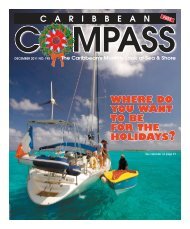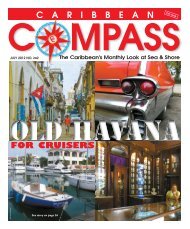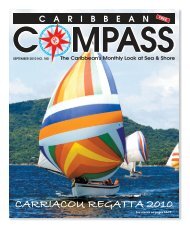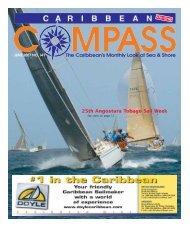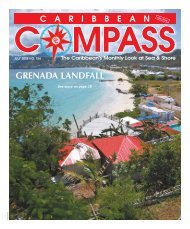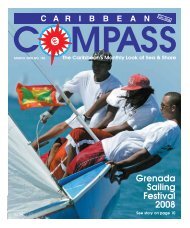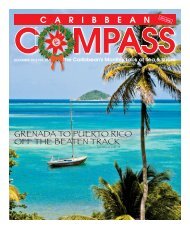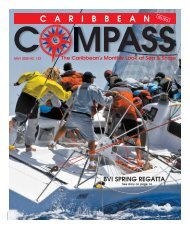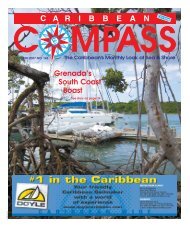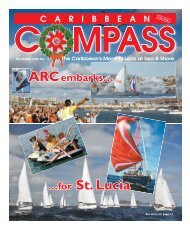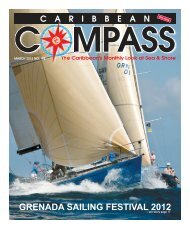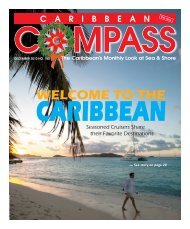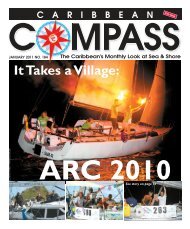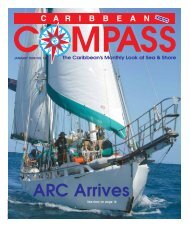Carriacou Regatta Festival 2007 - Caribbean Compass
Carriacou Regatta Festival 2007 - Caribbean Compass
Carriacou Regatta Festival 2007 - Caribbean Compass
You also want an ePaper? Increase the reach of your titles
YUMPU automatically turns print PDFs into web optimized ePapers that Google loves.
SEPTEMBER <strong>2007</strong> CARIBBEAN COMPASS PAGE 42<br />
Voiles Assistance<br />
Didier and Maria<br />
LE MARIN/MARTINIQUE<br />
Sails & Canvas (repairs & fabrication)<br />
located at Carenantilles dockyard<br />
Open Monday to Friday 8-12am 2-6pm<br />
Saturday by appointment<br />
tel/fax: (596) 596 74 88 32<br />
e-mail: didier-et-maria@wanadoo.fr<br />
MARTINIQUE<br />
BICHIK SERVICES<br />
Full Service Station:<br />
- Fuel/Diesel/Gas - Laundry - Call Station<br />
- Grocery - Ice - Cigarettes - Cold Drinks<br />
- Breakfast (Coffee, Croissants) - Fishing Items<br />
Conveniently located at<br />
Carenantilles Dockyard LE MARIN<br />
Tel: +596 74 70 94 Fax: +596 7478 08<br />
Mobile: +696 29 28 12<br />
Open 7am to 7pm Sundays: 7am to 1pm<br />
Marine<br />
Insurance<br />
The insurance business has changed.<br />
No longer can brokers talk of low rates.<br />
Rather, the honest broker can only say,<br />
“I’ll do my best to minimize your increase!”<br />
There is good insurance, there is cheap<br />
insurance, but there is no good cheap<br />
insurance.You never know how good your<br />
insurance is until you have a claim.<br />
Then, if the claim is denied<br />
or unsatisfactorily settled,<br />
it is too late.<br />
I have been in the insurance business<br />
40 years, 36 with Lloyds, and my claims<br />
settlement record cannot be beat.<br />
Fax DM Street<br />
Iolaire Enterprises (353) 28 - 33927<br />
or e-mail: streetiolaire@hotmail.com<br />
www.street-iolaire.com<br />
Readers’ Forum<br />
Dear <strong>Compass</strong>,<br />
Further to the ongoing discussion of the use of<br />
strobe lights on boats.<br />
I am one of those totally anarchy-plagued, survivalisttype<br />
chaps who left the USA for more than half my life<br />
and one of the first things that I learned was en pais qui<br />
vai uzenzo que trove, which means “in countries where<br />
you go, use what you find there”.<br />
In Venezuela, I find countless hundreds of fishing<br />
boats using single D-cell fisherman strobes, visible a<br />
maximum of two miles, usually set fairly low to the<br />
water and just about the only thing that works when<br />
seen against the backdrop of towns like Juangriego or<br />
Porlamar here in Isla Margarita. It ain’t exactly a cardinal<br />
light by any stretch of imagination, but it does<br />
get the old attention and forces folks to take a second<br />
look — because, after all, it is what works, not what<br />
suits all the maritime lawyers.<br />
I was run over twice and now use whatever works to<br />
keep this old engineless gaffer singlehander fool out of<br />
harm’s way. If you see a low intensity strobe — well,<br />
back off. Maybe I am 45 miles of shark-filled longline.<br />
As an oft-becalmed drifting gaffer, Mermaid pretty<br />
much fits the description of a drifting longliner —<br />
except my fishing line runs vertical, and might contain<br />
only four hooks. Short of flying two vertical red lights,<br />
signifying a vessel not under command, a singlehander<br />
who reduces sail to catch a bit of a nap often benefits<br />
by posing as a drifting fisherman. When I lie ahull<br />
or reduce speed, my normally towed surface fishing<br />
line becomes a deep line and Mermaid, in fact,<br />
remains a fishing vessel — a mini-longliner, if you will<br />
— and her hull becomes my marker pole and I use my<br />
fisherman’s “marker strobe”. Hopefully most marine<br />
lawyers and pinball wizards might see the difference<br />
between a marker strobe and a high-intensity masthead<br />
rescue strobe.<br />
I have spoken with several operators of ocean tugs,<br />
large fishing vessels and even an occasional cruise<br />
ship captain, all of whom agree that second to maintaining<br />
a good watch (sometimes awkward when singlehanding)<br />
a low-intensity strobe does get their attention<br />
and that is exactly what I want to do. My small<br />
strobe and often-encumbered running lights seem to<br />
indicate a small fishing vessel alongside of or hauling<br />
gear. Then a small course change on their part of as<br />
little a five degrees will keep their hull clear of any<br />
potential fouling gear and, most importantly, clear of<br />
my hull.<br />
I replaced the single D-cell battery in my fisherman’s<br />
strobe when I left Sint Maarten over three weeks ago<br />
and it still is working, as are similar lights on most of<br />
the vessels surrounding me here in Juangriego, and I<br />
have no intention of turning it off.<br />
On another safety matter, datura, called<br />
Burundanga in Venezuela, Borrachio in Colombia,<br />
and Angel’s Trumpet or Zombie Cucumber in the<br />
English-speaking islands, has hit the nightclub/party<br />
scene. Persons under the influence of these nightshade-family<br />
drugs can be asked to release passwords,<br />
empty bank accounts and engage in sexual<br />
acts without their consent or even their full knowledge.<br />
“The victim cannot say no,” says Dr. Camilo<br />
Uribe, head of Bogota’s foremost toxicology clinic, “It<br />
is like chemical hypnosis, and from the moment it is<br />
given the victim remembers absolutely nothing of<br />
what happened.” This substance can be given by liquid,<br />
cigarette or inhalant. It is tasteless and odorless.<br />
So, with the way things are with Burundanga just<br />
now, forget sidewalk romance! Flirting with a stranger<br />
could lead to a real Lost Weekend. There are probably<br />
countless people trying to figure out what happened to<br />
them on that long night out that they can’t remember<br />
when they were not careful with their drinks and woke<br />
up penniless and lost.<br />
Still no engine, still not a lot of sense, but plenty of<br />
success of the “stay afloat and be a sailor” kind.<br />
John Smith<br />
Mermaid of <strong>Carriacou</strong><br />
Dear <strong>Compass</strong>,<br />
After anchoring I usually snorkel out to check on the<br />
anchor and after seeing the patterns made by anchor<br />
chains as they scour the surface of the seabed have<br />
clambered back aboard feeling guilty and a bit<br />
depressed knowing that my anchor is going to be<br />
doing the same and not knowing what to do about it.<br />
I am one of the poorer folk afloat and have been an<br />
instigator of campaigns to keep anchoring fees down.<br />
Also I have treasured the right to drop my hook wherever<br />
I like. But those days are gone because we pleasure<br />
cruisers have already done too much damage in<br />
popular anchorages by our numbers, thank-you Mr.<br />
GPS. Now I welcome Frank Pearce’s suggestion in his<br />
letter in the July issue of <strong>Compass</strong> that we should<br />
support the provision of moorings in popular anchorages<br />
and maybe make some suggestions about their<br />
type and maintenance.<br />
For example, the moorings in Chaguaramas,<br />
Trinidad, are a nightmare. During the several months<br />
I used one, I tried every which way to stop the rode<br />
winding around the eye and the metal can from banging<br />
against the hull. From my favourite watering hole<br />
I could watch the can spin in the wake of passing<br />
boats. Eventually the rode was so short that when<br />
more wake came the yacht yanked its bow straight up.<br />
This action had led to the sand screws being pulled<br />
out on occasion.<br />
It would help me feel that I was getting value for<br />
money if the port authorities had leaflets describing<br />
their moorings, the installation and the maintenance<br />
of them; perhaps even including a recommended<br />
method of tying up to them for those of us unfamiliar<br />
with that particular type.<br />
Julia Bartlett<br />
Another Old Fart in Paradise<br />
Dear Julia,<br />
We asked Sharon McIntosh, General Manager of the<br />
Yacht Services Association of Trinidad & Tobago<br />
(YSATT), to comment on the mooring situation in<br />
Chaguaramas. Her response follows.<br />
CC<br />
Dear <strong>Compass</strong> Readers,<br />
Chaguaramas is an extremely vibrant multi-use<br />
harbour. The yachting community shares the bay<br />
with the fishing industry, energy sector, commercial<br />
maritime industry and local pleasure boat users. At<br />
all times, there are high levels of activity in the bay.<br />
Owing to the large and varied number of marine<br />
craft using Chaguaramas Bay, the Yacht Services<br />
Association of Trinidad and Tobago (YSATT) was<br />
mandated by the Marine Pilots to restrict the<br />
anchoring of yachts to a specific zone and provide<br />
clearly defined access channels to the inner parts of<br />
the bay. Maritime Services Division, the Marine<br />
Pilots and YSATT worked together to establish this<br />
anchorage zone.<br />
YSATT responded by establishing moorings to<br />
demark two entrance channels — one runs east/west<br />
along the northern shore and the other runs<br />
north/south along the eastern shoreline, that is, along<br />
CrewsInn’s ship dock. Within this area, yachts may go<br />
on anchor or rent one of the moorings that have been<br />
placed and are managed by YSATT. There are moorings<br />
in the bay that have been placed and are managed<br />
by private persons, however, the YSATT moorings<br />
are the only moorings approved and recognised<br />
by Maritime Services Division and the Marine Pilots<br />
Association. YSATT cannot account for moorings<br />
placed by other persons and users of these other<br />
moorings must be aware of this.<br />
Once a yacht takes up a YSATT mooring, the procedure<br />
is to immediately register with the YSATT office.<br />
Upon registration, the office supplies “Information for<br />
Users” to the cruiser with the following information:<br />
1) Each mooring consists of a 2,000-pound (approximately)<br />
concrete block, one-inch-thick nylon rope and<br />
three-eighths-inch chain attached to an orange floating<br />
buoy. There is a steel hoop at the top of the buoy<br />
for attachment of the boat’s bow rope. All moorings<br />
are clearly marked with “YSATT” and a number.<br />
2) There are only six to eight feet of extra line<br />
(scope) between the mooring block and the buoy. If<br />
users prefer to lift the mooring buoy slightly above the<br />
water to prevent banging, the buoy MUST be released<br />
at least 12 to 15 feet from the boat in times of bad<br />
weather. This allows the boat to ride the waves without<br />
lifting the mooring block. For this reason, when a<br />
boat is left unattended on an YSATT mooring, even for<br />
just a few hours, the buoy must be released by 12 to<br />
15 feet. Chaguaramas Bay can be subject to unpredictable<br />
weather, particularly between the months of<br />
June to November.<br />
3) Boats that weigh more than 15 tons or have particularly<br />
large superstructures are not permitted to<br />
use the moorings.<br />
4) Moorings are available on a first-come-first-served<br />
basis. Boats are welcome to attach to an available<br />
mooring but must register at the YSATT office, located<br />
in the Shipwright’s Building at Crews Inn, as soon as<br />
possible. The cost of a mooring is TT$30 per day or<br />
TT$750 per month (30 days).<br />
—Continued on next page



